THE BATTLE OF CULLODEN 1746 |
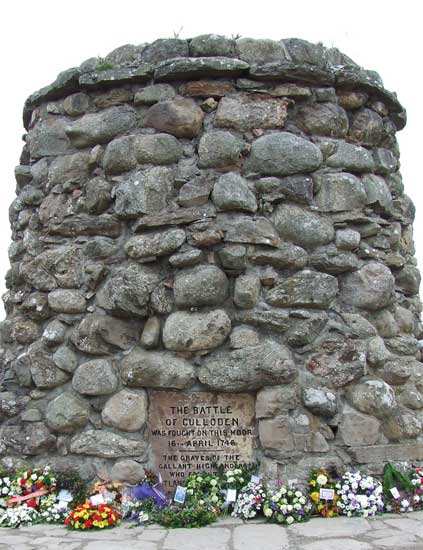 |
It was the greatest ever moment in the history of the Jacobite movement. Bonnie Prince Charlie and his army had victoriously marched down through England, and were poised to strike at London itself. Then, at the very moment of their triumph, the Young Pretender and his forces decided to turn back and retreat to Scotland. It was a decision which eventually turned out to be a disaster, because it led to their bloody and inglorious defeat at Culloden - the last military battle ever to be fought on British soil. With the capital in panic at the thought of a Jacobite advance, the prince was determined to press on to try and secure the British throne for his father, the exiled would be James VIII.
On his way north, the Scots fought off an attack at Clifton, in the Lake District and left 400 men to garrison the castle in Carlisle. |
The city was strongly pro-government, and hundreds of its men were fighting on the Hanoverian side against him. Reluctantly - and probably more to get rid of him than anything - Glaswegians did provide Charles with provisions to refit his army, which left 10 days later. By now, Edinburgh had been reclaimed for the king by General Henry Hawley and the Jacobites knew that a showdown was in prospect. Reinforced by the arrival of a further 4000 troops, they finally came face to face with Hawley's forces at Falkirk.
The battle was a disaster for the Hanoverians. They lost ten times as many men as the prince - 400 to 40 - with most of the government forces fleeing the field and leaving behind their artillery and baggage. |
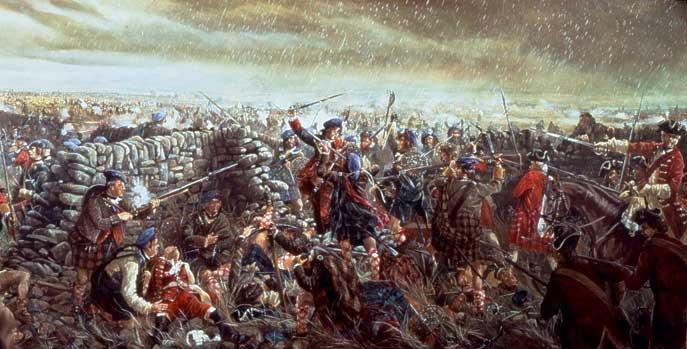 |
For the first time during the entire campaign, Charles decided to take personal command of his troops. He was outnumbered from the start - his 5000, ill shod, untrained and hungry men stood against nearly double the number of well fed, well equipped Hanoverians. Cumberland positioned his men, who were only about 400 yards away from the Jacobites, in two lines. The first was expected to break when the Highlanders attacked, but the second was carefully laid out three deep to provide massive and continuous firepower. The battle began with an artillery barrage by the Hanoverian forces. It lasted only a few minutes, but cut down many of the prince's men before they had a chance to charge. When the charge finally came, despite all Cumberland's carefully prepared positions, the fierce Highlanders still managed to break through the Hanoverian left flank. It was not enough to overcome the disadvantages of inferior firepower and sheer weight of numbers. For Bonnie Prince Charlie, however, there was to be no such ignominy. The flower of the Stewarts had fled the battlefield of Culloden before the fighting had even finished. The hero of the Jacobite rising had become the most wanted man in Britain, with a price on his head that the English imagined would be too large for Scots to turn down. The fight for the Stewart cause was over forever. The question now was whether the Prince would escape. |
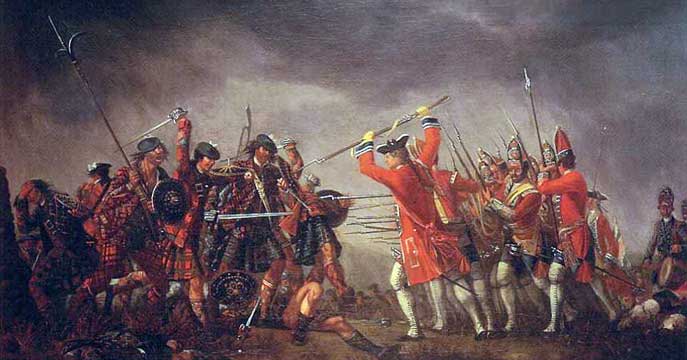 |
The rise and fall of Bonnie Prince Charlie is one of the most remarkable and romantic stories in Scottish history. The French had sent various rescue missions to try to find Charles and get him out of Scotland.
On September 19, they were finally successful. Charles emerged from hiding and boarded the frigate L'Heureux at Arisaig. It was the end of his adventure and of the Stewart threat to the British throne. |
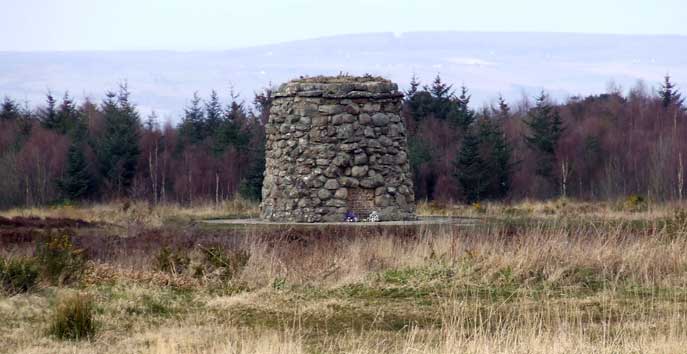 |
| Cumberland quickly consolidated his position by bringing thousands of British soldiers north. They were allowed to pillage the Highland Glens, raping the women and putting houses to the torch. The clan chiefs who had backed the Jacobite cause had their castles burned to the ground and their estates seized. Cattle were plundered and taken south, many of them bought by traders from Yorkshire. The plan was clear, to strip as much wealth as possible from the Highlands in the hope that the residents would starve and freeze to death. Even this however was not enough for some supporters of the Hanoverian cause. In London, parliament debated sterilising all women who had supported the Jacobites. Another suggestion offered was to clear the clans out and replace them with immigrants from the south. These suggestions were not acted on, but the law deliberately changed to suppress the Highland way of life. Highland dress was banned except that worn by regiments of the British army serving abroad, and anyone found wearing tartan illegally could be executed. The Hanoverians consolidated their grip on the north by extending their military presence. Field Marshal Wade's road system, originally built to open up the Highland's, was extended and military barracks constructed at places such as Fort George, near Inverness. Back in France, Charles received anything but a hero's welcome. He was banished to Italy two years after his return and, in 1750, secretly made his way back to London, where he is said to have proclaimed himself a Protestant and had a relationship with a woman he had first met in Scotland called Clementina Walkenshaw, whose sister was housekeeper to the Dowager Princess of Wales. She bore him a daughter, Charlotte. By this time, however, the Prince had lost his charm and become a violent brutish oaf. He beat Clementina so much that she eventually fled from him and, in 1772, he married the teenage Princess Louise of Stolberg. It was an ill fated match - by this time Charles was over 50 and a complete drunkard. He beat her too, and eight years after marrying him, she ran off with a poet. |
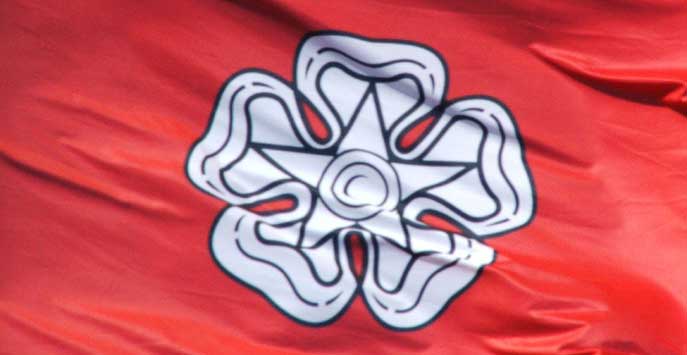 |
| Charles then invited his daughter Charlotte to share his home and made her the Duchess of Albany. He finally died in Rome in 1788, with the last rite performed by his brother Henry, the Cardinal Duke of York. In his will, he left most of his money to Charlotte - the Scots who had laid their lives on the line for him and the cause he represented didn't receive a penny. The Young Pretender's later life may have been wretched and unworthy, but at least he had money and status. The Highlanders he had used for his futile Jacobite campaign, then abandoned to their fate, faced only hostility and misery from a merciless Hanoverian regime. With their old bonds to the land and the clan system of rule broken, many opted to leave Scotland altogether. They sailed for the New World, settling in places such as North Carolina and working the land in order to make a living. As more and more Highlanders learned about the opportunities available to them in America, the numbers crossing the Atlantic swelled. It was the start of a mass emigration, which was eventually to lead to Scots becoming a powerful force in the establishment and development of the USA. Those who decided to take to the seas for a new life in the colonies included Flora MacDonald, who went with her husband Allan and two of their sons. Flora had been arrested for her part in helping Charles and taken to London, but she had been freed under the terms of a general amnesty and returned to Skye three years later. She went to America in 1774, where ironically her family helped fight for the Hanoverian King George III against rebels who were staging the first battles in what would ultimately become the successful American struggle against the British Crown for independence. After this, Flora returned to her native Skye, where she finally died in March 1790. During her lifetime, her fame had spread and thousands of people attended her funeral. She was buried in a sheet which Charles Edward Stewart had slept in during that fateful Jacobite campaign years before. Flora MacDonald had played only a small part in a campaign which changed the face of Scotland forever. But in death, she maintained her reputation and dignity - which is more than can be said for the man she risked everything to save, and whose vanity and desire for the throne almost destroyed the Highlands. |
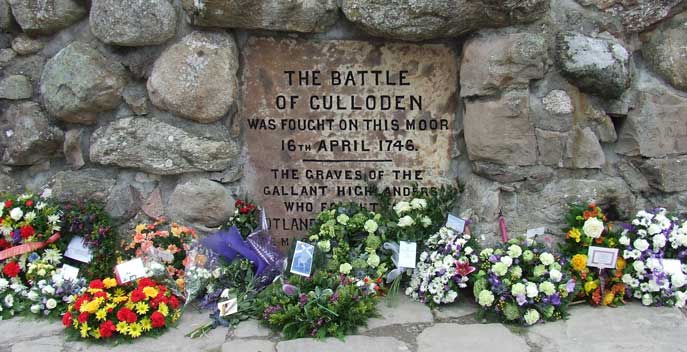 |
Our Thanks to NESS-SCAPE For This History Lesson |
 |
The Culloden Atrocities An Eyewitness Account |
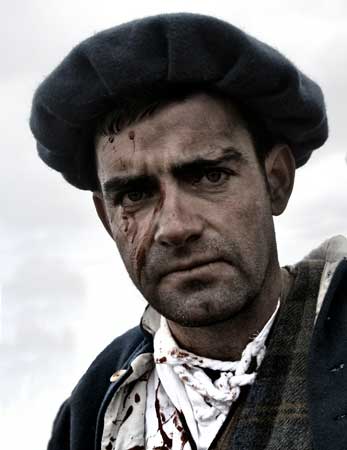 |
Few of the battles over the last 1,000 years, not just in Scotland or the Highlands itself, but within the rest of Britain, have left such a bitter legacy as the Battle of Culloden on April 16, 1746. Not even the horrific slaughter of the First World War, which claimed countless thousands of Scots, has the same sort of impact in the Highlands today - despite the encounter a short distance from Inverness 250 years ago barely matching a day's killing, for example, on the Western Front during the Somme offensive of 1916. The answer lies not in the battle itself, but in the conduct of the British Crown and its troops in the days, weeks and months following, when the last vestiges of rebellion and an ancient clan system disappeared in an orgy of systematic destruction. There is a belief - a mistaken belief - by many that the war waged by Prince Charles Edward Stuart was some kind of bloody liberation campaign to free the Scots from the grip of England, but that was certainly not the case. It was in essence a civil war, the driving force the restoration of the Stuart family to the throne. The Duke of Cumberland's army consisted not only of English troops, but Scottish clans, too, who had more desire to settle old scores than see a Prince they had little in common with restored to kingship. |
The battle itself was the culmination of a campaign which began with the landing of Bonnie Prince Charlie in the Hebrides onJuly 23, 1745. His army never experienced defeat until Culloden, almost 10 months later. Perhaps that, too, does much to explain the attocities commited by the government forces. |
Retribution |
In 1748 he received a narrative written by Mr. Francis Stewart, son of Bailie John Stewart of Inverness, who was 19 or 20 years of age at the time. It is worth quoting in fair detail, because it certainly gives an insight into the climate of fear which must have enveloped the area.
Mr Stewart writes, "It is a fact undeniable, and known almost to everybody, that upon Friday, the 18th of April, which was the 2nd day after the battle, a party was regularly detached to put to death all the wounded men that were found in and about the field of battle. That such men were accordingly put to death is also undeniable, for it is declared by creditable people who were eye-witnesses to that most miserable and bloody scene."
"I myself was told by William Rose, who was then greeve to my Lord President, that 12 wounded men were carried out of his house and shot in a hollow, which is within very short distance of the place of action. William Rose's wife told this fact to creditable people, from whom I had it more circumstantially.
"She said that the party came to her house, and told the wounded men to get up, that they might bring them to surgeons to get their wounds dress't. Upon which, she said, the poor men, whom she thought in so miserable a way that it was impossible they could stir, made a shift to get up; and she said they went along with the party with an air of cheerfulness and joy, being full of the thought that their wounds were to be dressed.
"But, she said, when the party had brought them the length of the hollow above mentioned, which is a very short distance from the house, she being then within the house, heard the firing of several guns, and coming out immediately to know the cause, saw all those brought out of her house, under the pretence of being carried to surgeons, were dead men."
The narrative carries on to tell of another party, under the command of a Colonel Cockeen, sent out to bring in the Lady McIntosh, a prisoner in her house at Moy. The Colonel found it ''impossible to restrain the barbarity of his party'' who spared neither sex nor age. Lady McIntosh counted more than 14 bodies between Moy and Inverness, men, women and children...
Mr Stewart also tells of the burning of a house near the battlefield containing 18 wounded men. This was apparently confirmed to Mr Stewart by a Mrs Taylor, a wright's wife at Inverness, who went to look for the body of a brother-in-law who had been killed.
Then he tells of the "very honest old gentleman, of the name of McLeod" pursued by two cavalrymen from near the battlefield to a hill near Inverness. When he couldn't run any longer, he went down on his knees and begged for his life. But he was shot through the head. The incident was witnessed by several inhabitants of Inverness.
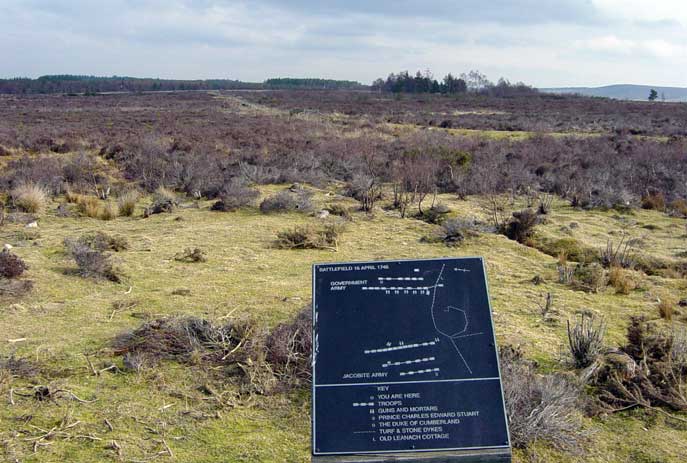 |
He relates, "A gentleman, falling sick in town, took a room at her house, being a retired place. He was in a violent fever the day of the action, and unable to make his escape when he was told the Prince and his army were defeat. Several soldiers coming up in the afternoon to this Widow Davidson's, the maid of the house told them there was a rebell above stairs, upon which they went immediately, rushed into the room wherein the poor gentleman lay, and cut his throat from ear to ear. This I was told by an honest woman, a neighbour of Mrs Davidson's, who went to the room and saw the gentleman after his throat was cut."
Mr Stewart goes on to describe the treatment of prisoners in the towns jail "so monstrous that I am certain there are few, if any, histories can parallel the like of it." Each received half a pound of meal a day, but not enough water to swallow it.
"I myself have gone often by the prison at that melancholy time, when I heard the prisoners crying for watter in the most pitifull manner. Many died at that time of their wounds, that were never dressed nor look't to, in the utmost agony."
The Rev James Hay, writing to Bishop Forbes in May 1749, records a catalogue of atrocities, including one dragoon who followed two "low countrymen" into a house and hacked them to death with his broad sword. "The maid heard their lamentable cries, and when he came out he was all blood. Poor men! they had no arms."
The Rev Hay goes on to describe the state of the prisoners, who were stripped when taken, with no regard paid to the "cryes of the wounded, or to the groans of the dying. No surgeon allow'd to apply proper remedies for their care or recovery, and when any of these were in the same unhappy circumstances their instruments were taken from them that they might give no relief. It was reckon'd highly crimenal and very dangerous to give them anything, even water."
He tells of the "prisoners' nurse", Anna McKaye, who brought comfort and help to the prisoners despite the danger. When a Mr Nairn escaped, she was taken to "the guard among a house full of sogars, and the orders were that she should not be allowed to sitt or ly down, and in that condition she was kept for three days and nights."
There was Murdoch McRaw, taken prisoner at Fort Augustus, who had nothing to do with the Prince. But within an hour of being sent to Inverness, he was hanged at the "Cross on the Apple Tree", his naked body left hanging for two days and a night and whipped for amusement.
The Rev Hay tells of Eavan McKay, jailed while delivering letters to Inverness. The letters were in French, and when he refused to tell who had written them or who they were for, was tied to a stake and given 500 lashes. Some days later he received 500 more, but still refused to speak After further harsh treatment he died. His father, reduced to begging in the street, was too afraid to claim his son and he was carried to his grave by two or three beggars. Even in death, one of Cumberland's soldiers thrust a bayonet several times into the body to "try (so he said) if the rebell was dead".
 |
Our Thanks to HIGHLANDER WEB For This History Lesson |
Jacobites Almost Won At Culloden |
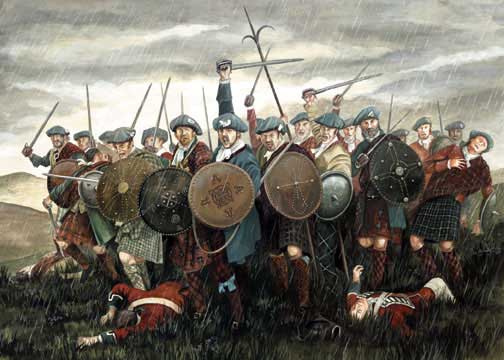 |
It was a decisive victory for the notorious Duke of Cumberland that marked the end of the '45 rebellion and left lasting scars of the Scottish psyche. For centuries, many historians believed that the red coated government soldiers at Culloden conclusively outfought the undisciplined Jacobite forces of Bonnie Prince Charlie. But new excavations at the site of the battle, which entered Scots folklore after its bloody denouement in 1746, revealed that the Jacobites came far closer to victory than most contemporary accounts suggest. Dr Tony Pollard, of the Two Men in a Trench programme, and a team from Glasgow University archaeological research division, has discovered that the Highlanders came close to |
breaking the government line and rewriting history.The almost suicidal attack of the Young Pretender's 7000-strong army, armed with dirks and broadswords, forced Cumberland and his troops loyal to George II to turn his heavy mortars, previously held in reserve, on to their serried ranks to prevent a rout of his troops, according to the new evidence. Dr Pollard's team also discovered various important artifacts, including a bayonet and a pewter cross – which would have been worn by a Jacobite warrior as he went into battle. His team made a huge metal detector survey of the battlefield, concentrating on the Field of the English area (actually a misnomer as the battle was not a simple England v Scotland conflict). They unearthed hundreds of musket balls and evidence of grape canister shot. He said: "It was clear that a huge amount of materiel was hurled at the Jacobites as they moved forward. We also managed to find, for the first time, the point at which the Jacobites hit home on the west of the government line. "The evidence shows that they came a lot closer to breaking through the lines than the histories of the battle suggest." First-hand accounts of the battle, fought near Inverness, speak of wild-eyed Jacobites being conclusively annihilated by a better-equipped, more disciplined government army. One source said that, in the dying moments of the battle, "Still a few rushed on, resolved rather to die than forfeit their well-acquired and dearly-estimated honour. They rushed on, but not a man ever came in contact with the enemy." However, Dr Pollard said the new evidence showed that the result was far from being a foregone conclusion. The graves of the Jacobite soldiers killed in the attack are well marked at Culloden, but experts were unsure of the location of government dead. However, an extensive survey by Dr Pollard's team has revealed the whereabouts of the burial site of Cumberland's men, who suffered about 260, killed or injured compared to about 1000 Jacobite casualties. He said: "The work shows how horrific the charge must have been. It was rewarding to find the government graves, as it is important to give a balanced interpretation of the site. "Both sides deserve respect. These men were just soldiers doing their job and many of the government troops would rather have been off in Flanders fighting the French. "The discovery of a pewter cross was particularly interesting and brought home the realities of the battle. The cross would have been kissed by a Jacobite as he went into battle and would have either fallen from him as he charged or been ripped from his chest as he tried to flee the field." The archaeological research was part of the preparatory work for a new £7m visitor centre at the battlefield. The National Trust for Scotland is to replace the 35-year-old building that receives 80,000 of the 250,000 people who visit the site every year. In 2004, Culloden, site of the last pitched battle on British soil, was ranked above Little Bighorn and just behind Antietam, a key battle in the American civil war, by US archaeologists in the rankings of the world's best battlefields to visit. |
 |
The Culloden Sword |
I was recently invited to a Wallace Society meeting in Elderslie Village Hall. Convenor David R. Ross told us of all the upcoming events concerning the Society, but the main event was still to come. Dr Hamish McLaren who is currently Chairman of the Clan MacLaren Society brought a sword that belonged to a young Jacobite called Donald McLaren and very kindly passed the sword round. Donald led the Appin Regiment and took part in the initial charge and was wounded. He was captured at the Braes of Leny but escaped by throwing himself into the Devil’s Beeftub near Moffat. Dr McLaren told us all about the sword, how it came to be in his possession, the fact that after Culloden Donald made his way to Carbridge then on to Aviemore and The Ruthven Barracks. The provenance of the sword seems to be water tight and holding that sword was a great experience. The sword is going to be on display at the new Culloden visitor centre where I'm sure you wont be able to hold it!!! A huge big thank you to Dr McLaren for letting us all hold a genuine piece of history in our hands....Alba Gu Brath |
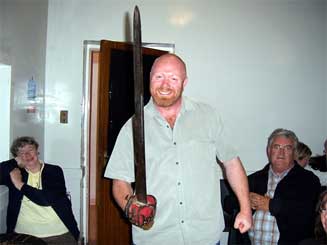 |
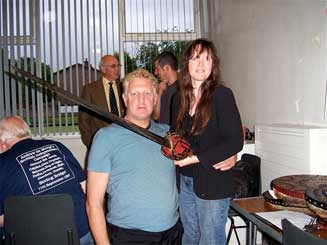 |
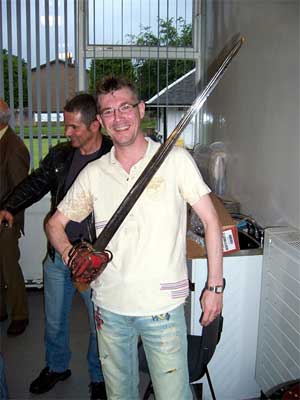 |
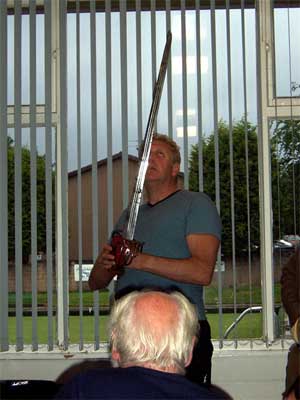 |
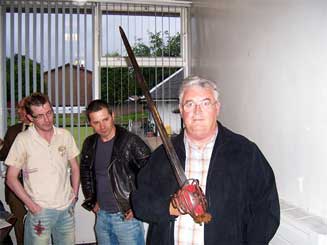 |
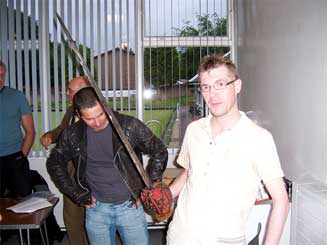 |
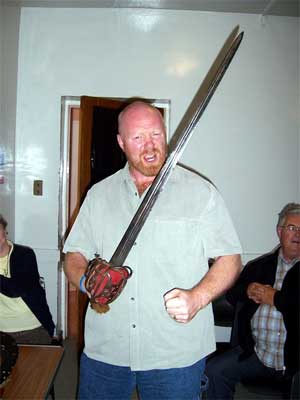 |
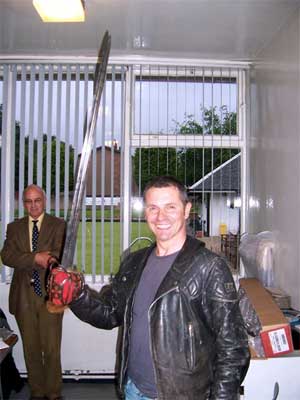 |
Our Sincerest Thanks To Dr Hamish McLaren For Bringing The Culloden Sword Along To Our Society Meeting. |
 |
© Paisley Tartan Army 2008-09
